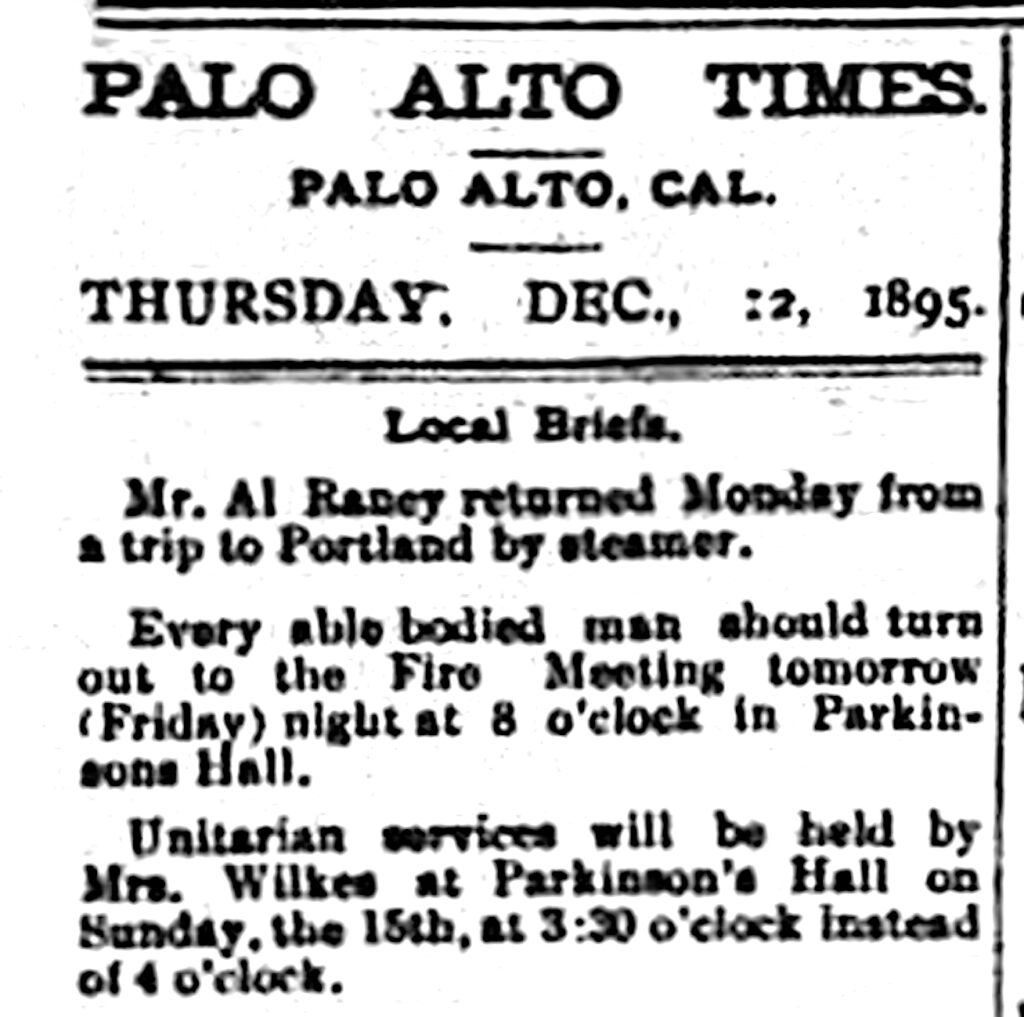Part One of a history I’m writing, which tells the story of Unitarians in Palo Alto from the founding of the town in 1891 up to the dissolution of the old Unitarian Church of Palo Alto in 1934. Rather than telling history as the story of a succession of (mostly male) ministers, my focus is on the lay people who made up the congregation. If you want the footnotes, you’ll have to wait until the print version of this history comes out in the spring of 2022.
The first Unitarian and Universalists in Palo Alto, 1891-1895
Unitarianism and Universalism arrived in Palo Alto before there was a congregation. Some of the first residents who arrived in Palo Alto in 1891, the year Stanford University opened, were already Unitarians and Universalists.
Emma Meyer Rendtorff began studying at Stanford University in 1894, eight months before Rev. Eliza Tupper Wilkes, a Universalist and Unitarian minister, preached the first Unitarian Universalist sermon in Palo Alto, at Stanford’s Memorial Church. Emma’s parents had been Unitarians, and as a girl she had attended Sunday school the Church of the Unity, a Unitarian church in St. Louis, Missouri. She was a lifelong Unitarian, and would play a key role when the Unitarian Church of Palo Alto was organized in 1905.
David Starr Jordan, the first president of Stanford, grew up in a Universalist family. As a young adult he briefly joined a Congregational church. While president of Stanford he disavowed any denominational affiliation, although he often spoke in Unitarian churches and at Unitarian gatherings. Whether or not he would have called himself a Unitarian or Universalist when he arrived in Palo Alto, he was often perceived as a Unitarian and often provided financial and moral support to the Palo Alto Unitarians. And when he retired from Stanford, he finally did join the Unitarian Church of Palo Alto.
Luna, Minnie, and Leander Hoskins were probably Unitarians before arriving in Palo Alto. Minnie moved in Palo Alto in 1892 when her husband Leander became a Stanford professor, and Luna had joined them in Palo Alto soon after. Luna and Minnie Hoskins were recognized as delegates by the Committee on Credentials of the Pacific Unitarian Conference at San Jose on May 1-4, 1895, a few days before Eliza Tupper Wilkes arrived in Palo Alto. Since they knew about Unitarianism before Eliza Tupper Wilkes arrived, she couldn’t have been the one to introduce them to Unitarianism, so it seems likely they had been Unitarians when they came to Palo Alto.
Eleanor Brooks Pearson, who came to Palo Alto in 1891 from South Sudbury, Massachusetts, may have been a Unitarian before she arrived in Palo Alto; her childhood home in South Sudbury would have been close to the Unitarian church in Sudbury Center, she was one of the organizers of the Unity Society in 1895, and she later married a Unitarian, Frederic Bartlett Huntington. Some sources hint that there were others who were Unitarians or Universalists before arriving in Palo Alto, but so far it has proved impossible to name them.

The Unity Society, 1895-1897
In November, 1892, the very first issue of the Pacific Unitarian, a periodical devoted to promoting liberal religion up and down the West Coast, declared that a Unitarian church should be organized in Palo Alto:
“The University town of Palo Alto is growing fast. Never was there a field that offered more in the way of influence and education than this. A [building] lot for a church ought to be secured at once, and the preliminary steps taken towards the organization of a Unitarian Society.”
Continue reading “Unitarians in Palo Alto, 1891-1905”